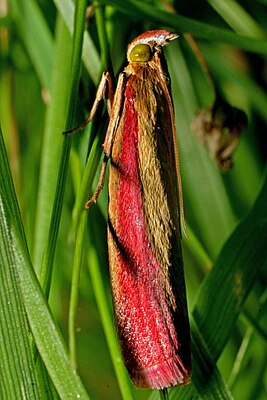Oncocera semirubella
| Oncocera semirubella | ||||||||||||
|---|---|---|---|---|---|---|---|---|---|---|---|---|

Oncocera semirubella |
||||||||||||
| Systematics | ||||||||||||
|
||||||||||||
| Scientific name | ||||||||||||
| Oncocera semirubella | ||||||||||||
| ( Scopoli , 1763) |
Oncocera semirubella is a conspicuously red and yellow marked small butterfly from the family of the common borer (Pyralidae).
features
The moths have a wingspan of 17 to 29 millimeters. The head and chest area are spotted yellow or yellow-red. The outer and front area of the fore wings is red, the rear yolk yellow. With the form f. sanguinella Hübner, the front edge is also colored yellow. The hind wings are cognac-colored, with a dark hemline and white fringes. A different form is known in which red is replaced by brown. The antennae are a good half as long as the forewings.
The caterpillar is green and has dark longitudinal lines. Her head is colored black.
Occurrence and habitat
The species occurs in almost all of southern and central Europe. In the north the distribution area extends to southern England, Denmark and southern Sweden. In the east it stretches over Turkey, Iraq and Iran to China. Oncocera semirubella prefers sunny, dry places overgrown with grasses and herbs . In Iraq, the moths are found in oases and in the steppe .
Phenology and way of life
The moths fly from May to September. They rest on the plants during the day, but are easy to find. They fly at dusk, come to artificial light sources and can also be baited. The caterpillars can be found in Central Europe from August to June of the following year; the caterpillars also overwinter. They live in tubular corridors made from a leaf woven with a loosely woven fabric. The food plants of the oligophageous species are alfalfa ( Medicago sativa ), common horn clover ( Lotus corniculatus ), clover species ( Trifolium ) and restockers ( Ononis ). They prefer to feed on the flowers, less often on the leaves of the plants. Pupation takes place in a silk cocoon in the living tube or in other places, usually on the food plant.
Harmful effect
The species can occur as a pest in alfalfa and clover fields, as well as on legumes (Fabaceae).
Systematics
The species was first described in 1763 by Giovanni Antonio Scopoli as Phalaena semirubella . A little later Carl von Linné named this form Phalaena Tinea carnella ; the name is therefore a more recent synonym. In 1796 Jacob Huebner described a form with a light yellow fore wing edge as Tinea sanguinella , which later turned out to be conspecific. The name is therefore a more recent synonym of Oncoceras semirubella . Phalaena Tinea carnella Linné, 1767 (= Phalaena semirubella Scopoli, 1763) is the type species of the genus Oncocera Stephens, 1829.
swell
Individual evidence
- ^ Zoological-Botanical Society in Vienna: Negotiations of the Zoological-Botanical Society in Vienna , 1927, Volume 76-78, page 81
- ↑ Süleyman Akbulut, Besir Yüksel and Akif Keten: The Lepidoptera (Insecta) Fauna of Düzce Province, Turkey. Turkish Journal of Zoology, 27: 257-268, Ankara 2003 ISSN 1300-0179
- ^ A b Edward Parr Wiltshire: The Lepidoptera of Iraq , Verlag N. Kaye, 1957
- ↑ S. Toll: Contribution to the microlepidopteran fauna of northeast Persia. Journal of the Vienna Entomological Society, 32 ((1947)): 107-116, Vienna 1948
- ↑ Fang, Li, Cui, Fa-liang, Li, Zhan-peng, et al .: Observation on the bionomics of Salebria semirubella. Senlin Bingchong Tongxun, 18 (2): 20-21, Shenyang 1999 ZDB -ID 1053288-2 .
- ↑ a b Slamka, p. 5
- ↑ Erno Kemenesy, Gusztáv Adolf Manninger: Alfalfa; Cultivation and plant protection , Akadémiai Kiadó, 1968, p. 179
- ↑ Paul Sorauer: Journal for plant diseases (plant pathology) and plant protection
literature
- Hans-Joachim Hannemann: Small butterflies or Microlepidoptera II. The curlers (sl) (Cochylidae and Carposinidae). The moth-like (Pyraloidea). In: Friedrich Dahl (Hrsg.): The animal world of Germany and the adjacent parts of the sea according to their characteristics and their way of life. 401 p., VEB Gustav Fischer Verlag, Jena 1964.
- Barry Goater: British Pyralid Moths . 175 pp., Harley Books, Colchester, Essex 1986, ISBN 978-0946589081
- Eugene G. Munroe, M. Alma Solis: The Pyraloidea . In: Niels Peder Kristensen (Ed.): Lepidoptera, Moths and Butterflies. Volume 1: Evolution, systematics, and biogeography . In: Maximilian Fischer (Ed.), Handbook of Zoology. Volume IV Arthropoda: Insecta , Part 35. pp. 233-256, Walter de Gruyter, Berlin 1998, ISBN 3-11-015704-7
- František Slamka: The common moth (Pyraloidea) of Central Europe: determination - distribution - flight area - way of life of the caterpillars . 2nd partially revised edition, 112 pp., Bratislava 1997, ISBN 8-096-75402-5
- Thomas Kaltenbach, Peter Victor Küppers: Small butterflies. Verlag J. Neudamm-Neudamm, Melsungen 1987, ISBN 3-788-80510-2
Web links
- Oncocera semirubella at Lepiforum eV
- Global information system common moth
- Naturhistoriska Riksmuseet Stockholm (Swedish)
- Moths and Butterflies of Europe and Northern Africa (English)
- UKMoths Ian Kimber (English)
